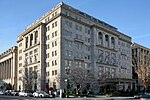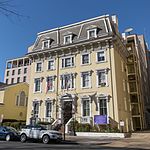Black Lives Matter Memorial Fence
The Black Lives Matter Memorial Fence (BLM Memorial Fence) was a two-block eight-month long protest art installation of Black Lives Matter memorials attached by visitors and community activists to the chain link fence outside the White House on H Street, between Vermont Avenue and Connecticut Avenue NW in Downtown Washington, D.C. in 2020 and 2021. The 1.7-mile (2.7 km) cordon of fencing around the White House was erected to move the growing crowds of protesters gathered at and around Lafayette Park after the murder of George Floyd on May 25, 2020. The Memorial Fence developed from June 2020 until it was dismantled and archived in January 2021. Members of the public worked together to maintain, protect, and then archive the thousands of signs and artworks that were offered by the public.
Excerpt from the Wikipedia article Black Lives Matter Memorial Fence (License: CC BY-SA 3.0, Authors).Black Lives Matter Memorial Fence
H Street Northwest, Washington
Geographical coordinates (GPS) Address Nearby Places Show on map
Geographical coordinates (GPS)
| Latitude | Longitude |
|---|---|
| N 38.900138888889 ° | E -77.036527777778 ° |
Address
Saint John's Episcopal Church
H Street Northwest 1525
20006 Washington
District of Columbia, United States
Open on Google Maps









